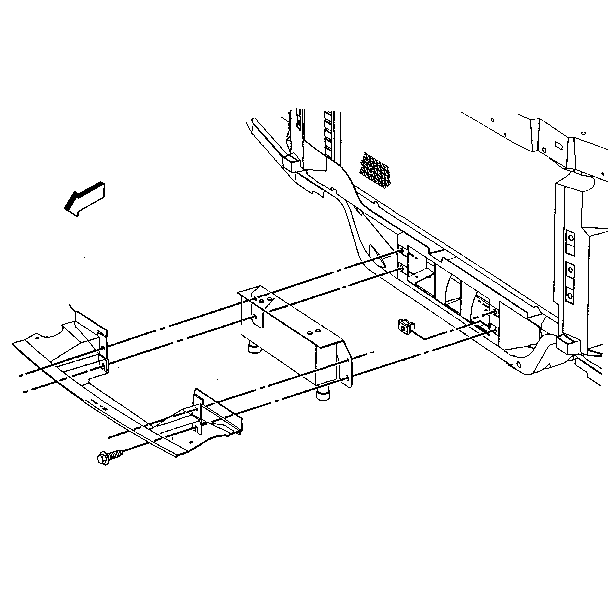General Description
This vehicle has a pressure-type engine cooling system. A thermostat
controls the coolant circulation.
The cooling system consists of the following components:
| • | A radiator pressure cap (gasoline engines) |
| • | A coolant recovery reservoir (gasoline engines) |
| • | A coolant surge tank and surge tank cap (diesel engines) |
| • | A cooling fan and fan clutch |
| • | A coolant pump and pulley |
A 103 kPa (15 psi) radiator or surge tank cap seals the
cooling system, causing the system to operate at a higher than atmospheric
pressure. The high pressure operation raises the boiling point of the coolant
to about 125 ° C (257 ° F), increasing
the cooling efficiency of the radiator.
The pressure-vacuum valve radiator cap, used with gasoline engines,
allows the coolant to expand through the pressure valve in the center of the
cap without building up unnecessary pressure. The expanding coolant flows
into the coolant recovery reservoir and the vent valve closes because of coolant
expansion and flow. Any air in the system is forced into the coolant recovery
reservoir and then out of the vent tube at the top of the reservoir. As the
system cools, vacuum forces the coolant in the reservoir back to the radiator
through the vent valve. Because of this, the radiator remains full at all
times.
The diesel engine uses a cooling system with a surge tank. The pressure
cap for the diesel engine differs from the gasoline engine pressure cap. The
cap is on the surge tank. The diesel engine uses a pressurized surge tank.
Coolant circulates through the surge tank. The surge tank allows the escape
of any air in the system and provides room for coolant expansion when the
coolant is hot.
The cooling system reaches 103 kPa (15 psi) in either
system only after the system reaches normal operating temperature.
Engine Coolant
This vehicle has a newly developed engine coolant. GM Goodwrench DEX-COOL™
was developed to last for 166 000 km (100,000 mi) or
5 years, whichever occurs first. Follow the instructions in Draining/Filling
Cooling System. Make sure only GM Goodwrench DEX-COOL™ (orange-colored,
silicate-free) is used when coolant is added or changed.
A 50/50 mixture of ethylene glycol (GM Goodwrench DEX-COOL™) and
water will provide the following protection:
Notice: Pure coolant can be added to raise the boiling point of the coolant,
but too much will affect the freezing point. Do not use a solution stronger
than 70 percent, as the freeze level rises rapidly after this point.
Pure coolant will freeze at -22°C (-8°F).
| • | Give freezing protection down to -37°C (-34°F). |
| • | Give boiling protection up to 129°C (260°F). |
| • | Protect against rust and corrosion. |
| • | Help keep the proper engine temperature. |
| • | Let the warning lights and gauges work correctly. |
Fan and Clutch
The fan and the clutch mount to the water pump. The clutch has a heat
sensitive spring that contracts as the engine temperature changes. This factor
determines how fast the fan blades turn in order to cool the radiator.
Temperature Lamp Switch
This switch activates a warning lamp in the Instrument Panel Cluster
if the engine overheats. With optional instrumentation, a temperature gauge
replaces the warning lamp and a transducer replaces the temperature switch.
For location and diagnosis of the switch, refer to Temperature Lamp Switch
in Electrical Diagnosis.
Radiator Air Baffle Assemblies, Deflectors, and Seals

A deflector redirects air flow. Deflectors are installed under the vehicle
and redirects the air flow beneath the vehicle to flow through the cooling
system. The deflectors perform the following functions:
| • | Increase radiator cooling |
Air baffles are used to direct air into the radiator and A/C condenser.
Air seals ensure that air passes through, and does not bypass, the radiator
and the A/C condenser. A missing, damaged, or incorrectly installed baffle
or seal may cause the engine to overheat.
Cooling System Circulation
The front engine-mounted coolant pump is belt driven. Coolant from the
radiator outlet flows to the coolant pump inlet, and the coolant is pumped
through coolant passages in the crankcase and into the cavities surrounding
the cylinders. Coolant then flows through holes in the cylinder head gaskets
into the cylinder head coolant passages.
Passages in the intake manifold direct the coolant to the thermostat.
When the thermostat is closed, the coolant is prevented from returning to
the radiator, and the coolant is recirculated for quick engine warm-up.
When the engine reaches operating temperature, the thermostat opens,
and the coolant flows to the inlet tank on the top left side of the radiator.
The coolant is cooled as the coolant flows across the horizontal core tubes
to the outlet tank on the right side of the radiator. This completes the coolant
flow cycle.
Uncommon Cooling System Problems
Problems not requiring disassembly of the cooling system:
| • | Large obstructions that block the radiator or the air conditioning
condenser; The following are some examples of large obstructions: |
| • | Front mounted bike carriers |
| • | Front mounte tire carriers |
| • | Missing or damaged air baffle or lower air deflector |
Problems requiring disassembly of the cooling system:
| • | An incorrect or damaged fan |
| • | Faulty emission system components (could cause overheating at
idle) |
| • | Positive Crankcase Ventilation (PCV) valve |
| • | Pressure testing the cooling system with the radiator cap installed |
| • | Plugged or incorrect radiator |
| • | The cylinder head gasket |
| • | A damaged intake manifold or intake manifold gasket |
| • | Plugged coolant passages in the cylinder head(s) |
| • | An incorrect thermostat that has been installed |

